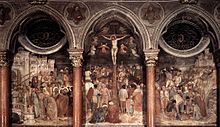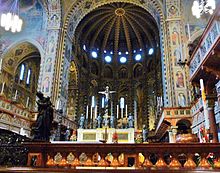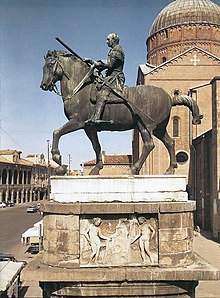Basilica of Saint Anthony (Padua)

The Basilica of St. Anthony ( Italian : Basilica di Sant'Antonio , regionally often just Basilica del Santo or simply Santo ) in Padua is one of the most famous and most visited shrines in Italy . It is one of the 8 international sanctuaries in the world . It is a papal basilica and a minor basilica . It is the first large vaulted church building in the Terraferma and was built between 1232 and around 1310 in the Romanesque - Gothic style around the tomb of the saintAnthony of Padua († 1231 in Arcella, now part of Padua).
history
In Antony's time there was a small chapel on the site of today's church, which was consecrated to Maria Mater Domini and, according to Antony's will, became his original burial place. A monastery was built next to this chapel in 1229, which Antony himself probably founded. The foundation stone of the first part of the basilica was laid shortly after Antonius' death in 1232 in order to build a suitable burial church for him. First a small single-nave Franciscan church with a short apse was built; only later were the two aisles, the numerous chapels, domes and towers added. The original chapel was incorporated into the basilica on the site of the current Chapel of the Black Madonna in the left transept. After the choir was completed around 1310, the building of the church was completed. From 1690 to 1737 the treasure chapel (Italian: Cappella del Tesoro) crowned with a dome was added to the head of the choir based on plans by Filippo Parodi. The church was restored in the 19th century, with baroque fixtures removed again.
Facade and architecture
The basilica is 118 m long and 32.5 m wide, the short transept 55 m wide. The greatest interior height is 38.5 m. The church has a three-nave nave, a polygonal choir, ambulatory and chapel wreath in the east. The nave and broad transept are in the typical architectural style of Italian mendicant churches . The ambulatory choir, the chapel wreath (similar to San Francesco in Bologna ) and the intermediate yoke inserted into the transept are of French origin.
The 37 m high and 28 m wide facade is the oldest part of the church building. It consists of red bricks with a Romanesque-Lombard arched frieze as the gable end . Five blind arcades with pilaster strips on the lower facade with the Gothic influence of the pointed arches carry the Romanesque dwarf gallery with open railing above it halfway up the facade. Their arcades rest on capitals in the late Romanesque and Byzantine styles. Above that, a Gothic rose window between two biforias adorns the gable, which is crowned by a bell tower. The facade alone unites Venetian-Byzantine, Lombard-Romanesque and Gothic elements. The bronze doors were made by Camillo Boito in 1895 . Above the main entrance there is a lunette painting depicting Anthony and Bernardine of Siena with the monogram of Christ. It is a copy of the work painted by Andrea Mantegna in 1452 , the original of which is in the Museo antoniano di arte sacra. The statue of Anthony above is also a copy of an original by Rinaldin von Puydarrieux from the 14th century, also in the Museo antoniano di arte sacra.
The eight domes similar to the 5-domes system of St. Mark's Basilica in nearby Venice , the two slender, hexagonal and 68 m high bell towers and two minaret-like turrets are typical features of the Byzantine architectural style . The angel on the conical dome over the crossing is enthroned at a height of 72 m. Two more rose windows on the sides of the high altar illuminate the interior of the church.
inner space
Gothic and Romanesque style elements stand out in the interior of the basilica. Donatello's masterpieces dominate the chancel . The group of sculptures is the basilica's most famous work of art. The current arrangement of the 7 sculptures and 21 reliefs that have been preserved dates from 1895, when today's high altar was erected.
On the left side there is a rising candelabra of bronze , a work from 1515: because of its size and its artistic quality, it is considered one of the most beautiful candelabra in the world. The dominant feature, however, is the crucifix by Donatello (1444–1450) - a masterpiece of the Renaissance .
The sculptures depict from left to right: Louis of Toulouse , Justina of Padua , Francis of Assisi , Madonna and Child, Antonius of Padua , Daniel (Padua's patron saint) and Prosdocimus .
At the lower altar there is a relief of the Man of Sorrows in the middle , surrounded by putti on the right and left. Four reliefs show the symbols of the evangelists , on the lower right the eagle of John. The miracles of Saint Anthony of Padua are also depicted on four reliefs: the miracle of the attached foot (front left), the heart of the avaricious (front left), the miracle of the newborn who testifies to the innocence of his mother and the miracle of the donkey that takes place to eat kneels in front of the host (both back of the altar). On the back of the altar there is also a stone relief of the Entombment of Christ.
Typical of the basilica are the many tombs and side chapels that were built in honor of some nobles, scholars and church princes, especially between the 15th and 17th centuries.
The sacrament chapel on the right was built in Gothic style in 1457 to house the tombs of Gattamelata , a 15th century condottiere , and his family. The bronze tabernacle is the work of Girolamo Campagna . His sarcophagus and that of his son Giannantonio († 1456; right) protrude from the walls . In 1651 the chapel was transformed into a sacrament chapel. The current rich decoration goes back to the years 1927–36.
The beautiful chapel of St. James in the right transept is one of the main works of the 14th century in Italy due to its architecture and its magnificent frescoes . It was named Felix Chapel in 1503 after receiving the relics of Pope Felix. Between 1377 and 1379 it was painted by Altichiero da Zevio and the Bolognese painter Avanza. In addition to the crucifixion group, one of Altichiero da Zevio's main works, the story of the Holy Apostle Jacob, the patron saint of Spain, whose sanctuary is in Santiago de Compostela, is told . The elegant, Gothic designs of the chapel come from the then greatest architect and sculptor in Venice, Andriolo de Santi .
Behind the high altar is the "Treasure Chapel" (1691). The "treasure" consists of some relics of the saint, such as B. the tongue, which was found intact during a first grave opening in 1263. The reliquary is a Florentine work of gold-plated silver (1434–36). Another reliquary from 1349 contains the lower jaw and a third the cartilage of the vocal cords.
In the left transept you can find the entrance to the original monastery church, today called the Chapel of the Black Madonna ( Cappella della Madonna mora ). This is where Antony prayed for sure, and this is where he was first buried. Today he rests in the adjoining burial chapel. It was started around 1500 and completed at the end of the 16th century, but is still Gothic. On the walls there are nine marble reliefs from the 16th century with scenes from the life and miracles of St. Anthony created by Tullio Lombardo , his brother Antonio , Girolamo Campagna , Jacopo Sansovino , Giovanni Maria Mosca and others.
Cloisters
The church has a total of five cloisters . The current one, the novitiate cloister , is usually not accessible.
The other cloisters can be reached directly from the right side exit of the church. First you come across the cloister of the magnolia , which owes its name to the huge Magnolia grandiflora (from 1810) in the middle of the square. The architecture has remained unchanged since 1433. Here, too, as in the other courtyards, there are tombstones, damaged frescoes, sculptures, and a souvenir shop.
From this souvenir shop you can reach the General's cloister (1435). It owes its name to the halls of the General Minister , who lives in this building during his visits . From here you can get to the cloister of Blessed Luca Belludi . This is the largest and sunniest cloister. Built between 1496 and 1612, it also combines Gothic elements with those of the Renaissance. It was only returned to the monks a few years ago after it had belonged to the state since the Napoleonic occupation and housed the State Archives, the Museum and the Library of Padua.
The forecourt of the basilica once served as a cemetery; some tombs testify to this. Today it is dominated by the statue of the Condottiere Erasmus da Narni - the aforementioned Gattamelata . This statue is a bronze sculpture by Donatello from 1453. It is the first equestrian statue cast in Italy since the Roman era.
organ
The organ of the St. Anthony's Basilica was built in 1929 by the organ building company Mascioni (Azzio, Va.). The instrument has 59 registers on three manuals and a pedal .
|
|
|
|
|||||||||||||||||||||||||||||||||||||||||||||||||||||||||||||||||||||||||||||||||||||||||||||||||||||||||||||||||||||||||||||||||||||||||||||||||||||||||||||||||||||||||||||||||||||||||||||||||||||||||||||||||||||||||||||||||||||||||||||||
-
Couple
- Normal coupling: II / I, III / I, III / II, I / P, II / P, III / P
- Sub-octave coupling: II / I, III / I, III / II
- Super octave coupling: II / I, III / I, III / II
- Melody coupling: III / I, III / II
See also
literature
- Reclam's art guide. Northern Italy East . Arranged by Erich Egg, Erich Hubala u. a. Stuttgart 1965. pp. 309-319.
- Klaus Zimmermanns: Venetia - The cities and villas of the Terraferma . DuMont, Cologne 2009, ISBN 978-3-7701-4356-6 , pp. 196-199.
Web links
- Website of the abbey
- http://www.basilicasantantonio.va/content/sanantonio/it/guida.html ( Memento of December 31, 2013 in the Internet Archive ) (basilicasantantonio.va, Italian) accessed on March 19, 2013
- The Basilica of St. Anthony as a 3D model in SketchUp's 3D warehouse
- Basilica of Saint Anthony (Padua) on the ETHorama platform
Individual evidence
- ↑ gcatholic.org
- ↑ a b c d e Zimmermanns: Venetien - The cities and villas of Terraferma, 2009, p. 190
- ↑ a b c d e f g http://www.basilicasantantonio.va/content/sanantonio/it/guida/la-basilica.html ( Memento of December 30, 2013 in the Internet Archive ) (basilicasantantonio.va, Italian) on March 19, 2013
- ↑ The Basilica of St. Antonius, Edizioni Messagiero Padova, p. 3
- ↑ Reclams Art Guide, Northern Italy East. 1965. p. 309.
- ↑ a b Reclams Art Guide, Northern Italy East. 1965. p. 311.
- ↑ Padua inside and outside. Storti, Venezia, 2010, p. 75
- ↑ Reclams Art Guide, Northern Italy East. 1965. p. 310.
- ↑ The Basilica of St. Antonius, Edizioni Messagiero Padova, pp. 3, 25
- ↑ The burial chapel of St. Anthony. In: santantonio.org. Retrieved September 2, 2019 .
- ↑ Information on the organ of the basilica (PDF file; 23 kB)
Coordinates: 45 ° 24 '4.9 " N , 11 ° 52' 48.2" E












